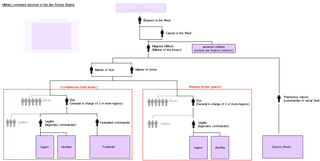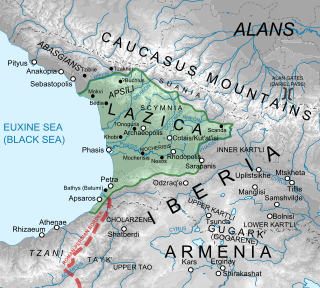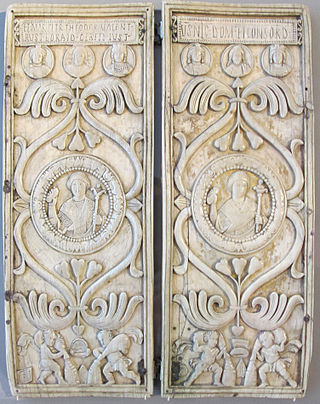Related Research Articles
Year 536 was a leap year starting on Tuesday of the Julian calendar. At the time, it was known as the Year after the Consulship of Belisarius.

Magister militum was a top-level military command used in the late Roman Empire, dating from the reign of Constantine the Great. The term referred to the senior military officer of the empire. In Greek sources, the term is translated either as strategos or as stratelates.

The Lazic War, also known as the Colchidian War or in Georgian historiography as the Great War of Egrisi, was fought between the Byzantine Empire and the Sasanian Empire for control of the ancient Georgian region of Lazica. The Lazic War lasted for twenty years, from 541 to 562, and ended with the Fifty-Year Peace Treaty, which obligated the Byzantine Empire to pay tribute to Persia each year for the recognition of Lazica as a Byzantine vassal state by Persians. The Lazic War is narrated in detail in the works of Procopius and Agathias.
TheodoricStrabo was a Gothic chieftain who was involved in the politics of the Eastern Roman Empire during the reigns of Emperors Leo I, Zeno and Basiliscus. He was a rival for the leadership of the Ostrogoths with his kinsman Theoderic the Great, who would ultimately supplant him.

The Praetorian Prefecture of Africa was an administrative division of the Byzantine Empire in the Maghreb. With its seat at Carthage, it was established after the reconquest of northwestern Africa from the Vandals in 533–534 by the Byzantine Emperor Justinian I. It continued to exist until 591, when it was replaced by the Exarchate of Africa.
Sittas was a Byzantine military commander during the reign of Emperor Justinian I. During the Iberian War against the Sassanid Empire, Sittas was given command of forces in Armenia, similar to the status of Belisarius in Mesopotamia. He won a victory over the Sassanids at the battle of Satala.

Flavius Mar. Petrus Theodorus Valentinus Rusticius Boraides Germanus Iustinus, simply and commonly known as Justin, was an Eastern Roman aristocrat and general. A member of the Justinian Dynasty and nephew of Emperor Justinian I, he was appointed as one of the last Roman consuls in 540, before going on to assume senior military commands in the Balkans and in Lazica. He fought against the Slavs, the Sassanid Persians and supervised the Byzantine Empire's first contacts with the Avars. At the time of Justinian's death, he was seen as a probable successor, but was beaten to the throne by his cousin, Justin II, who exiled him to Egypt, where he was murdered.
John, surnamed Mystacon, was a prominent Eastern Roman general in the wars with Sassanid Persia during the reigns of Byzantine emperors Tiberius II and Maurice.
Cours or Curs, also known as Coursos, Cursos, Qwrys, Crous or Crus, was an East Roman (Byzantine) general of the 6th century.
Hermogenes was an Eastern Roman official who served as magister officiorum, military commander and diplomatic envoy during the Iberian War against Sassanid Persia in the early reign of Emperor Justinian I.
Godilas was a Byzantine general, active in the reigns of Emperor Justin I and Emperor Justinian I.
Adolius was a Byzantine silentiarius and military officer, active in the reign of Justinian I. He was a son of Acacius, proconsul of Armenia Prima. He is better known for his activities in the early stages of the Lazic War. The main source about him is Procopius.
Solomon was an East Roman (Byzantine) general from northern Mesopotamia, who distinguished himself as a commander in the Vandalic War and the reconquest of North Africa in 533–534. He spent most of the next decade in Africa as its governor general, combining the military post of magister militum with the civil position of praetorian prefect. Solomon successfully confronted the large-scale rebellion of the native Berbers, but was forced to flee following an army mutiny in spring of 536. His second tenure in Africa began in 539 and it was marked by victories over the Berbers, which led to the consolidation of the Byzantine position. A few years of prosperity followed, but were cut short by the rekindled Berber revolt and Solomon's defeat and death at the Battle of Cillium in 544.
Bessas was an Eastern Roman general of Gothic origin from Thrace, primarily known for his career in the wars of Justinian I. He distinguished himself against the Sassanid Persians in the Iberian War and under the command of Belisarius in the Gothic War, but after Belisarius' departure from Italy he failed to confront the resurgent Goths and was largely responsible for the loss of Rome in 546. Returning east in disgrace, despite his advanced age he was appointed as commander in the Lazic War. There he redeemed himself with the recapture of Petra, but his subsequent idleness led Justinian to dismiss him and exile him to Abasgia.

Arbāyistān or Beth Arabaye was a Sasanian province in Late Antiquity. Due to its situation and its road systems, the province was a source of income from commercial traffic, as well as a constant area of contention during the Roman–Persian Wars.
Dagisthaeus was a 6th-century Eastern Roman military commander, probably of Gothic origin, in the service of the emperor Justinian I.
The siege of Petra took place in 549 when the Eastern Roman (Byzantine) Empire, under Emperor Justinian I, besieged the strategic fortress of Petra in Lazica, held by the Sasanians. Petra's garrison took heavy casualties, but it stood firm until the arrival of a strong army under Mihr-Mihroe relieved the siege.
The Battle of Anglon took place in 543 AD, during the Byzantine invasion of Sasanian-ruled Armenia ("Persarmenia").
The siege of Petra was fought in 550 AD, between the Byzantines under general Bessas, and the Sasanian Persian garrison of Petra in the buffer state of Lazica. The strategic fortress had previously been held by the Byzantines before it was seized in 541 by the Sasanian king Khosrow I, and his Lazi allies. This conquest gave the Sassanian Empire access to the Black Sea and marked the beginning of the Lazic War. After a failed attempt to recapture Petra in 549, the Byzantine emperor Justinian I sent an army under Bessas to retake the fortress. The Byzantine historian Procopius described the resulting siege in vivid detail.
John Tzibus or Joannes Tzibus was a general of the Byzantine emperor Justinian I. He served as the magister militum per Armeniam, replacing the unpopular Peter by 535 at the latest. He founded the port city of Petra, Lazica, through which he monopolized the trade in Lazica, acting as a middleman. This triggered the Lazic king Gubazes II to switch sides. John Tzibus was killed by an arrow in the neck in 541 AD during the siege of his fortress by the Sasanians, who were now allied with the Lazic king. This marked the beginning of the Lazic War between the Sasanians and the Byzantines.
References
- 1 2 Rogers, Clifford J.; DeVries, Kelly; France, John (2012). Journal of Medieval Military History. Boydell Press. p. 8. ISBN 9781843837473.
- ↑ Cancik, Hubert; Schneider, Helmuth (2002). Brill's Encyclopaedia of the Ancient World New Pauly: Lyd-Mine. Brill. p. 70. ISBN 9789004122710.
- ↑ Martindale, John R., ed. (1992). The Prosopography of the Later Roman Empire: Volume III, AD 527–641. Cambridge: Cambridge University Press. p. 845. ISBN 0-521-20160-8.